Helper CLI commands
Here is a list of helpful built-in command-line commands that come with centrifugo executable.
version
To show Centrifugo version and exit run:
centrifugo version
genconfig
Another command is genconfig:
centrifugo genconfig -c config.json
It will automatically generate the configuration file with some frequently required options. This is mostly useful for development.
If any errors happen – program will exit with error message and exit code 1.
genconfig also supports generation of YAML and TOML configuration file formats - just provide an extension to a file:
centrifugo genconfig -c config.toml
checkconfig
Centrifugo has special command to check configuration file checkconfig:
centrifugo checkconfig --config=config.json
If any errors found during validation – program will exit with error message and exit code 1.
defaultconfig
The defaultconfig generates the configuration file with all defaults for all all available configuration options. See docs
It supports all three config file formats which Centrifugo recognizes:
centrifugo defaultconfig -c config.json
centrifugo defaultconfig -c config.yaml
centrifugo defaultconfig -c config.toml
Also, in dry-run mode the output will be sent to STDOUT instead of file:
centrifugo defaultconfig -c config.json --dry-run
Finally, it's possible to provide this command a base configuration file - so the result will inherit option values from the base file and will extend it with defaults for everything else:
centrifugo defaultconfig -c config.json --dry-run --base existing_config.json
defaultenv
In addition to defaultconfig Centrifugo now has defaultenv command (docs). The defaultenv prints all config options as environment vars with default values to STDOUT. Run:
centrifugo defaultenv
It also supports the base config file to inherit values from:
centrifugo defaultenv --base config.json
When using --base, if you additionally provide --base-non-zero-only flag – the output will contain only environment variables for keys which were set to non zero values in the base config file. For example, let's say you have Centrifugo v6 JSON configuration file:
{
"client": {
"allowed_origins": ["http://localhost:8000"]
},
"engine": {
"type": "redis",
"redis": {
"address": "redis://localhost:6379"
}
},
"admin": {
"enabled": false
}
}
Running:
centrifugo defaultenv --base config.json --base-non-zero-only
Will output only variables set in config file with non zero value (admin.enabled skipped also):
CENTRIFUGO_CLIENT_ALLOWED_ORIGINS="http://localhost:8000"
CENTRIFUGO_ENGINE_REDIS_ADDRESS="redis://localhost:6379"
CENTRIFUGO_ENGINE_TYPE="redis"
configdoc
Another command is configdoc:
centrifugo configdoc
Once you run it, a web server will start on port 6060 and you can open the following URL in your browser – http://localhost:6060 – to see the generated HTML page with all Centrifugo configuration options described, with default values, environment variable tips and description:

If you pass --markdown flag, the output will be in Markdown format to stdout:
centrifugo configdoc --markdown
Also supports filtering by top level configuration section:
centrifugo configdoc --section=consumers
gentoken
Another command is gentoken:
centrifugo gentoken -c config.json -u 28282
It will automatically generate HMAC SHA-256 based token for user with ID 28282 (which expires in 1 week).
You can change token TTL with -t flag (number of seconds):
centrifugo gentoken -c config.json -u 28282 -t 3600
This way generated token will be valid for 1 hour.
If any errors happen – program will exit with error message and exit code 1.
This command is mostly useful for development.
gensubtoken
Another command is gensubtoken:
centrifugo gensubtoken -c config.json -u 28282 -s channel
It will automatically generate HMAC SHA-256 based subscription token for channel channel and user with ID 28282 (which expires in 1 week).
You can change token TTL with -t flag (number of seconds):
centrifugo gentoken -c config.json -u 28282 -s channel -t 3600
This way generated token will be valid for 1 hour.
If any errors happen – program will exit with error message and exit code 1.
This command is mostly useful for development.
checktoken
One more command is checktoken:
centrifugo checktoken -c config.json <TOKEN>
It will validate your connection JWT, so you can test it before using while developing application.
If any errors happen or validation failed – program will exit with error message and exit code 1.
This is mostly useful for development.
checksubtoken
One more command is checksubtoken:
centrifugo checksubtoken -c config.json <TOKEN>
It will validate your subscription JWT, so you can test it before using while developing application.
If any errors happen or validation failed – program will exit with error message and exit code 1.
This is mostly useful for development.